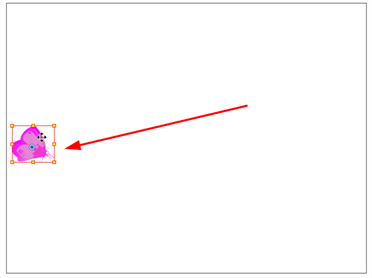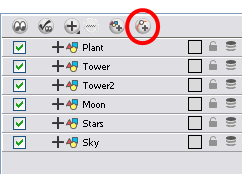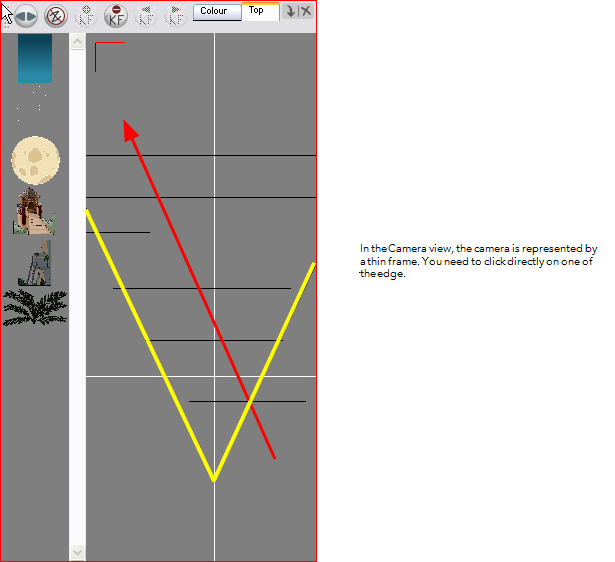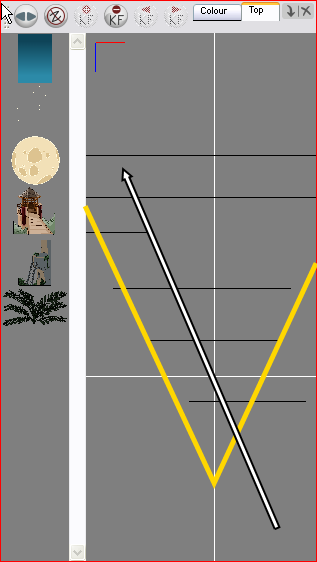How to Animate Objects and the Camera
This topic is divided as follows:
| • | Animating a Layer |
| • | Animating the Camera |
Animating a Layer

You can create a motion path directly on your layers.
Drawing layers can house drawings and symbols. Also, in that same layer you can create a motion path using keyframes and all the artwork contained in the layer will follow.

You can control and define your trajectory using several different parameters. These parameters are:
| • | X, Y and Z positions |
| • | Angle (rotation) |
| • | Skew |
| • | X and Y scales |
Each parameter has its own function curve where you can add keyframes and control the easing.
Do not worry about using graphs and function curves if you are not familiar with this concept. Animate has a series of easy-to-use tools for visually controlling your trajectories in the Camera view.
To animate a simple object such as an arrow in flight or a wheel spinning, you can use the integrated trajectory. Also, each part of a cut-out puppet will be animated directly on the drawing layer.
Follow these steps to perform a basic layer animation.
To animate a layer:
| 1. | In the Tools toolbar, select the Transform |
| 2. | In the Transform Tool Properties view, make sure that the Peg Selection Mode |
| 3. | In the Tools toolbar, click the Animate Mode |
| 4. | In the Timeline view, go to the first frame. |

| 5. | In the Camera view, select the element to animate and move it to its first position. |

| 6. | In the Timeline view, go to the frame on which you want to set the second position. |


| 7. | Play back |
Animating the Camera
The camera is treated the same way as any other element. The same tools and selection modes are used to offset or animate it. To animate the camera, you need to connect it to a peg element.

This means that you can animate the camera visually, with the function curve, or by typing values in the Xsheet column.
To add a camera with a peg to your scene:
| 1. | If you do not already have a camera layer, do one of the following: |
| ‣ | From the top menu, select Insert > Camera. |
| ‣ | From the Timeline view layers toolbar, click the Add Layers |
| ‣ | In Animate, select a Camera module from the Library view and drag it to the Network view. |
A new camera layer is added to the scene and appears in the Timeline view.
| 2. | From the Timeline View Layer toolbar, click the Add Peg |

A Peg layer appears directly above the Camera layer. The Camera layer is automatically attached to it.
The Peg layer automatically takes the name of the camera and adds the suffix -P to indicate that it is a Peg layer, for example Camera-P.

If the new Peg layer did not appear directly above the camera, you may have clicked elsewhere in the scene, which deactivated the layer on which you want to add the Peg layer.
| ‣ | Select the Camera layer and drag and drop it under the new Peg layer. Or delete the misplaced Peg layer, select the Camera layer and click the Add Peg |
You are now ready to animate your camera.
Make use of both the Top and Camera views while making camera moves. You can open this view is one of two ways:
| ‣ | From the top menu, select Windows > Top. |
| ‣ | From any existing window already open in your project, click the Arrow |
The Top view appears as a tab in that view.

To animate the camera:
| 1. | Make sure both the Animate |
| 2. | In the Top, Side or Camera view, select the camera (the large V-shape on the right side) and move it to the desired position. |
| 3. | In the Camera view, the camera is represented by a thin frame. You need to click directly on one of the edge. |

| 4. | In the Timeline view, click on a cell in the Camera Peg layer where you would like the camera move to begin. |
| 5. | Right-click (Windows) or [Ctrl]+Click (Mac OS X) and select Insert Keyframe. |

A keyframe appears in that cell. Any frames preceding this keyframe cell will hold the same camera position as in this keyframe.
| 6. | Click on another cell a bit further down your scene’s Timeline. This is where the camera move will end. |
| 7. | Select the camera in the Top view and move it to the desired position. |

A second keyframe appears and a line is created between the two frames to indicate that the subsequent motion between the frames will be calculated and rendered by the program.
| 8. | Play back |
You are now ready to animate your camera.
It is recommended to use both the Top and Camera views while making camera moves. You can open this view is one of two ways:
| • | From the top menu, select Windows > Top. |
| • | From any existing window already open in your project, click the arrow |

To animate your camera:
| 1. | Make sure that the Animate |
| 2. | In the Top, Side or Camera view, select the camera and move it to the desired position. |
| ‣ | In the Top and Sive view, the camera is the large V cone. You need to click directly on one of the edge. |
| ‣ | In the Camera view, the camera is represented by a thin frame. You need to click directly on one of the edge. |

| 3. | In the Timeline view, click on a cell in the Camera Peg layer where you want the camera move to begin. |
| 4. | Right-click and select Insert Keyframe. |

A keyframe appears in that cell. Any frames preceding this keyframe cell will hold the same camera position as in this keyframe.
| 5. | Click on another cell, further down your scene's Timeline, where you want the camera move to end. |
| 6. | Select the camera in the Top view and move it to the desired position. |

A second keyframe appears and a line is created between the two frames to indicate that the subsequent motion between the frames will be calculated and rendered by the program.
| 7. | Play back |